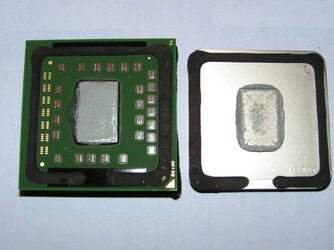As usual no one answered his questions, just went off on a side track rambling
Anyway, here are some signs the IHS has poor contact
1.High Load temps (especially on water): Obviously if you have high load temps with water the IHS is a problem. A good way to check this is load prime, and run it for about an hour. Then quickly shut down the PC, and remove the waterblock. If it's cool to the touch then there is little energy transfer to the waterblock.
2.Large Delta between Idle/Load (water): Most people with watercooling have large heatercores that have the capacity to disapate a much larger amount of energy than the cpu can source. Without the IHS temps are usually within 5-10C load/idle. If the delta is large (10C+) then the IHS is a problem.
3.Large Increase in Temps/Voltage (water): Again capacity of watercooling as sink is usually greater than source of CPU. When you scale voltage, and the temp rises fast with water, IHS is a problem. Example with my Opteron 170 temps between 1.30v and 1.58v is 5C at load.
4.One core overclocks significantly better than the other: Both cores are obviously manufactured closely together. Their quality should be about the same in terms of overclockability. If one overclocks a lot better than the other, the IHS contact with 1 core is probably poor. Example: One core on my 170 would do 3000, the other had trouble at 2900 with IHS. Removed IHS, then the 2nd core does 2980 steady.
Should you remove the IHS?
Well that depends on you. If you trust yourself, don't plan to sell the cpu soon, if you can afford to replace it,if you are on water, and the cpu seems to have more potential from removing the IHS, then I'd do it. With air it's probably a waste of time, but with water the results are usually worth it.
How to check if it will help you OC?
A good method to see if removing the IHS would be worthwhile, is to lower the temps so your load would be about what you expect from removing the IHS. This obviously varies by CPU and cooling systems. As an example my IHS was semi steady at 2900. I lowered the room temps so CPU load was around 38C, and it was steady at 2950 or so.
I removed the IHS, and it made it to 2980 with load around 38C with normal room temps.


